8 simple 3m plain disc mower options for grass farmers
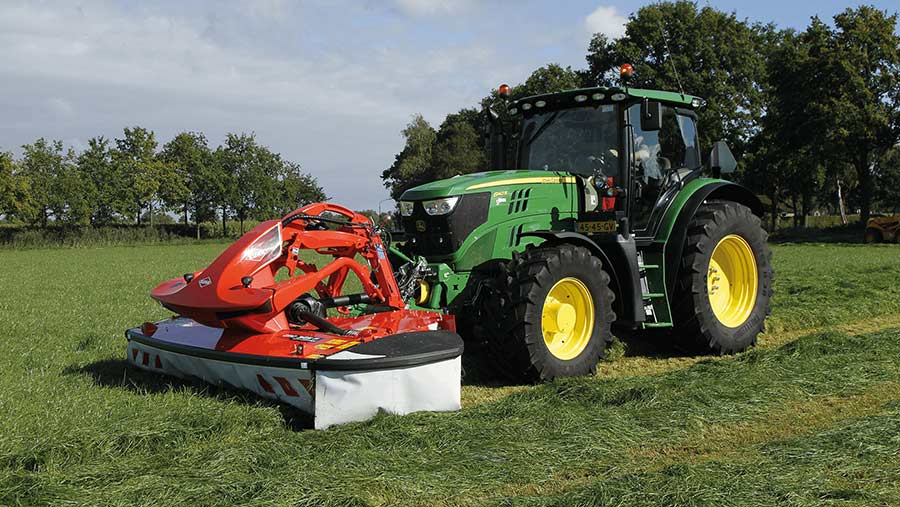 Kuhn GMD 3125 F © Kuhn
Kuhn GMD 3125 F © Kuhn Mower conditioners might offer the benefit of bruising grass so that it dries out faster, but they’re heavier than their plain disc equivalents, more expensive and take more power to run.
As a result, increasing numbers of farmers are opting to keep things simple and do without a conditioner.
Dairy producers carrying out multiple silage cuts are increasingly moving in this direction as there’s less material to wilt.
See also: 7 low-cost fertiliser spreaders for smaller farms
However, there’s also a market for those who ted the grass shortly after mowing, which offers a degree of conditioning in its own right.
The simplest plain disc mowers come with a belt drive and have a simple suspension setup, but more premium models offer the same direct drive and build quality as their conditioning cousins.
Here, we’ve featured a few examples from the major players and listed guideline prices for models around the 3m mark.
Where possible, we’ve tried to source on-farm prices, but some are listed with retail figures and will be subject to dealer discount.
Specifications and sizes vary slightly between the models we’ve picked out, so this isn’t a direct price comparison. However, it should give you a rough idea of how much you’ll need to pay.
Kuhn

Kuhn GMD 3125 F © Kuhn
Kuhn’s GMD 1011-series disc mowers come in working widths from 2.67m to 3.5m and feature a hydro-pneumatic suspension system that helps the bed follow ground contours.
This so-called “Lift Control” setup uses a pendulum-type articulation that allows the mower to float and, thanks to adjustable accumulators, operators can alter pressure from the cab to suit the conditions.
In addition, there’s an automatic break-back that allows the beds to swivel by 25deg to clear any obstacles before returning to the working position of its own accord.
For added protection, the GMD’s mower beds are connected to the chassis using rubber shock absorbers and the shaft holding the disc is designed to shear in the event of any hard impacts, shielding the rest of the driveline.
These can be replaced in about 15mins.
Each disc holds two knives, which can rotate freely through 360deg and have a sprung quick-release system for speedy changes.
For transport, the mower pivots to the rear so that it is carried lengthways. It’s also stored in this position.
The 3.1m 3111FF comes with seven discs, produces an average swath width of 2.3m and has a retail price of £15,800.
For those looking to add a front mower, the 3125F-FF is the most suitable partner. This offers a 3.1m working width and has a pull-type headstock with hydro-pneumatic suspension. The list price is £22,560.
SIP
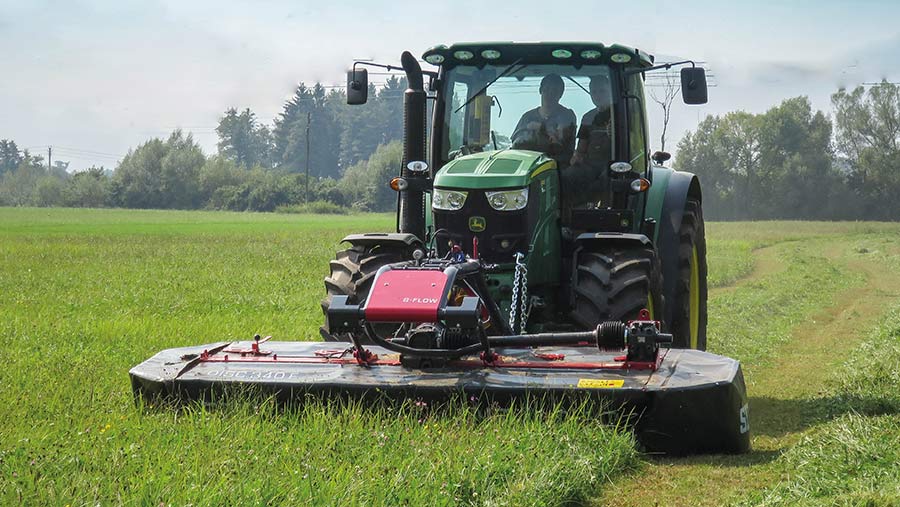
SIP Silvercut Disc 300F S Flow © SIP
The Silvercut is the premium plain disc mower offered by Slovenian maker SIP and it has a direct mechanical driveline, as well as a hydro-pneumatic suspension system with in-cab pressure adjustment.
Other features include a sequential lift, which raises the inside of the cutterbar before the outer, and automatic break-back that allows the bed to move backwards and upwards to clear obstacles.
For transport, the deck lifts vertically and sits at a 120deg angle behind the tractor so that the weight is centralised.
It can also be stored in this position so that it takes up less space, although buyers do have to order specific stands to be able to do this.
Cutterbars feature Hardox steel skids and are fitted with oval discs that carry two retractable, quick-release blades.
They also have a protection system with four replaceable brass pins that shear in the event of a hard impact, which SIP says are quick to change.
The popular Silvercut Disc 300S comes with seven discs, has a 2.9m working width and costs about £10,500 on-farm. Two larger models are available, topping out with the nine-disc 380S that offers a 3.67m working width.
A suitable front mower would be the 300F, which shares the same bed as its rear counterpart, but has the option of a simple A-frame push-type headstock or a more sophisticated pull arrangement with hydro-pneumatic suspension.
The firm says the former is adequate for a plain mower setup and this costs about £11,500 on-farm.
Pottinger
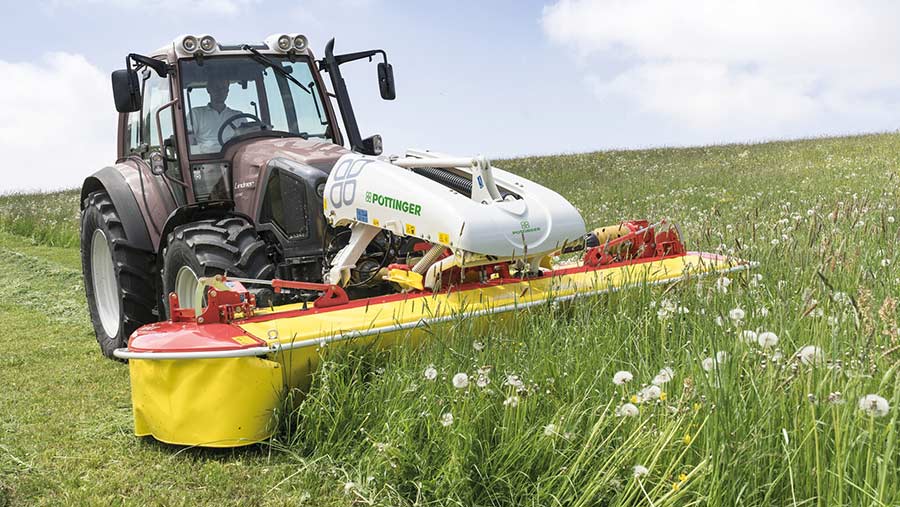
Pottinger Novacat 301 AM © Pottinger
Hailing from Austria, Pottinger’s Novacat plain disc mowers can be had in working widths from 2.62m to 4.3m.
In each case, these are suspended from the centre of the mower bed and feature an adjustable hydraulic system to provide uniform ground pressure.
There’s a stabilising cylinder that prevents the mower from swaying during lifting, which is said to make it easier to drive over swaths and improve stability during transport.
Mechanical collision protection comes as standard on smaller models and an automatic hydraulic system is available as an upgrade. However, this is standard fitment on models with seven discs or more.
As for the cutterbar, this sits at just 4cm high to improve crop flow and has a smooth leading edge to help it ride over soil. There are cleaning paddles to prevent any dirt that does flick up accumulating.
Each disc carries two swinging blades, which are held in place by a sprung quick-release system.
These are run via a mechanical driveline with bevel gears that are designed to have three teeth in contact to improve power transfer and increase strength.
Stub shafts are bolted directly to the gears, and are designed to be easily replaced if damaged by an impact.
The Novacat 302 comes with seven discs that offer a 3.04m working width and it costs about £12,084 on-farm.
Its front-mounted equivalent is the £13,919 Novacat 301 AM Master, which offers a 3.04m working width and has a compact pull-type headstock that means it can be used by smaller four-cylinder tractors.
Vicon, Kverneland and Kubota
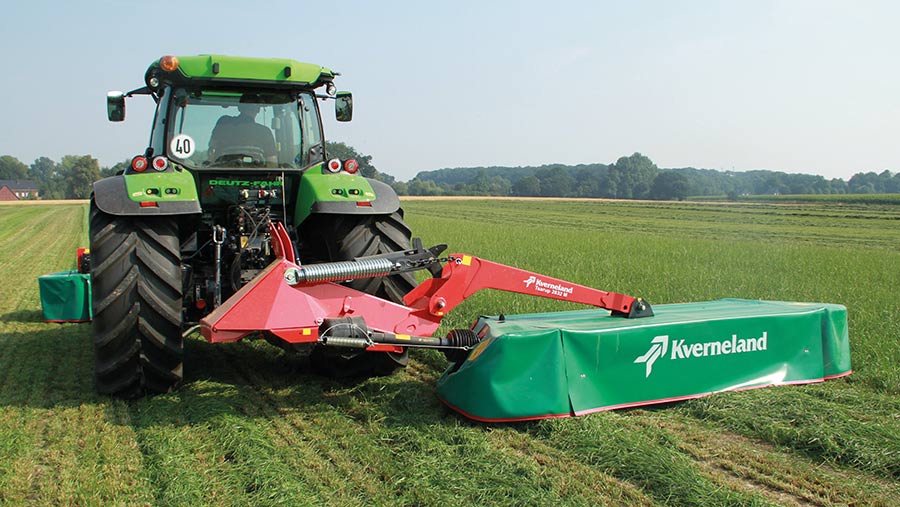
Kverneland 2832M © Kverneland
The three brands listed above offer a broadly similar array of mowers, but while Kverneland chooses to use a two-bladed round disc, Kubota and Vicon have opted for a three-blade triangular setup.
The firms’ premium plain disc offerings come in the form of the 2800 range from Kverneland, Vicon’s Extra 300 series and the Kubota DM3000s.
All come with the option of working widths from 2.8m to 4m and they use a conventional spring to adjust ground pressure.
However, this can be fitted with hydraulic adjustment so that it can be altered from the tractor cab.
In both instances, the bed is suspended from the centre to keep it balanced and give uniform ground pressure.
To protect against collisions, there’s also a sprung breakaway system that allows the beds to swing backwards and over the obstacle before returning automatically to work.
For added versatility, the mowers come with a two-speed gearbox that allows them to run at either 540 or 1,000rpm.
Kverneland’s decision to run a round disc with two blades is driven largely by the fact that it reduces the risk of stone damage and shock loads on the transmission, while Vicon and Kubota’s three-blade setup offers more cuts to a turn.
Models with eight discs and a 3.16m working width include the Kverneland 2832M, Vicon Extra 322 and Kubota DM3022. The first two come in at about £11,500 on-farm, but the Kubota is currently cheaper at £9,300.
Each can be allied to a 3.2 front mower, which has a pull-type headstock and sprung suspension. These cost between £11,400 and £11,800 on-farm.
Krone
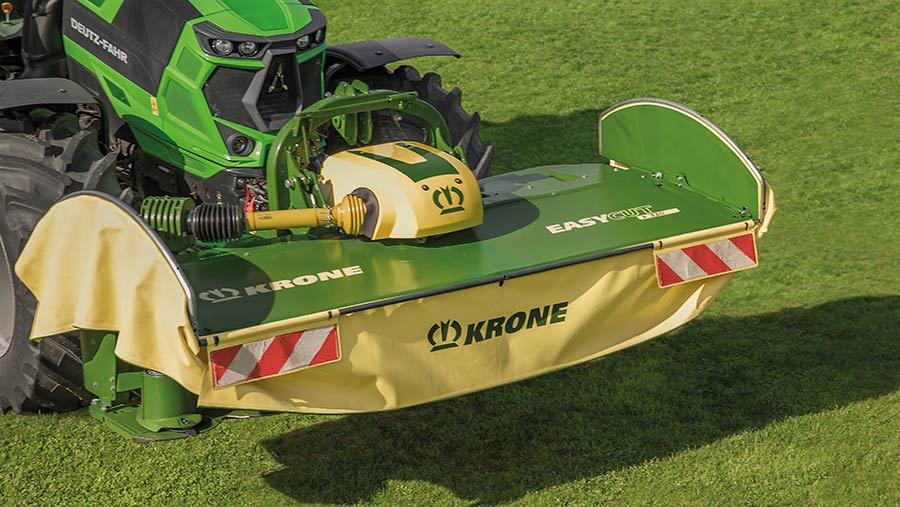
Krone EasyCut F320 © Krone
Krone’s offering in this arena is the Easycut R range, which comes with a full mechanical driveline and the option of manual or hydraulic ground pressure control.
In both cases, suspension is provided by a spring, but the hydraulic version allows tension to be adjusted from the cab. There’s also an automatic impact protection system that works much like the other models featured.
Working widths from 2.73m to 4.04m are available and all have over-centre vertical pivoting to improve stability. Thanks to a folding side guard, this setup helps reduce height for road transport.
Mower beds use Krone’s satellite driveline, which has large spur gears to maximise the number of teeth engaged at any one time.
Added to that, each disc has its own impact protection built in, with a roll pin that shears before any damage is done to the driveline.
The Easycut R320 offers a working width of 3.16m and costs about £12,800 on-farm.
Its front-mounted equivalent is the F320 G3, which offers the same working width, has a pull-type headstock and comes in at about £15,300.
Claas
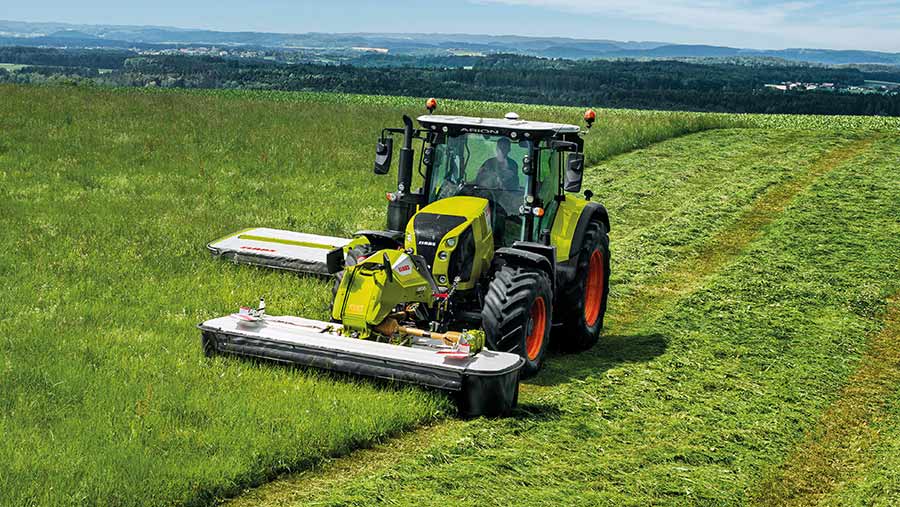
Claas Disco 3200F © Claas
Claas offers a host of plain mowers to suit different budgets, but the Disco Contour models are most popular among farmers and small contractors with large amounts of ground to cover.
Working widths are available from 2.6m to 4.2m and they are centrally mounted so that they articulate and hug ground contours.
They also feature hydro-pneumatic suspension with in-cab adjustment of ground pressure, plus mechanical break-back protection.
In lighter crops they have the option of being run at 850rpm, rather than the standard 1,000rpm, to help save fuel.
The cutterbar has a wave-shaped profile that allows the discs to be positioned nearer the front, as well as wide skids that act as spoilers to deflect dirt and protect the mower base.
Each disc is fitted with two knives that can rotate though 360deg and they have a sprung retaining mechanism that makes them quick to replace.
A so-called “safety link” module is also incorporated, which shears when hitting a solid object, protecting the driveline from damage.
The Disco 3200 Contour comes with seven discs that give a 3m working width, and it has a retail price of £13,640.
It can be paired with either the pull-type 3200F Profil that comes in at £16,310, or the £19,770 3200F Move, which has a more sophisticated headstock that offers smoother operation on undulating terrain.
New Holland
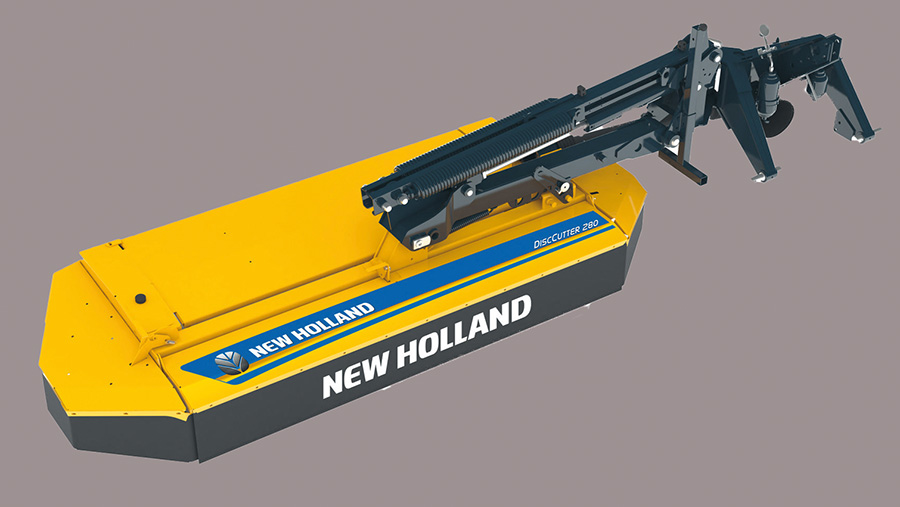
New Holland DiscCutter 280 © New Holland
New Holland’s mowers are a continuation of the models produced by JF Stoll and Kongskilde and come in simple DuraDisc guise or as part of the fancier DiscCutter range.
The latter is available with cutting widths from 2.77m to 3.86m and has a centrally mounted bed with hydraulic suspension and a hydraulic break-back system.
Cutterbars have a low profile and feature oval discs with two quick-release knives. These are mounted on hubs that are designed to shear when they hit a solid object.
For transport, the bed can either be folded vertically to 90deg or swung horizontally to the rear.
The DiscCutter 320 comes with eight discs that offer a 3.11m working width and it has a retail price of £16,747.
This is typically teamed with the £15,739 DuraDiscF300 front mower that cuts to 2.96m and has a push headstock with pendulum flotation system.
However, those that want more ground-hugging ability can upgrade to the DiscCutter F version that has a pulling headstock with trapeze-style suspension.
Massey Ferguson
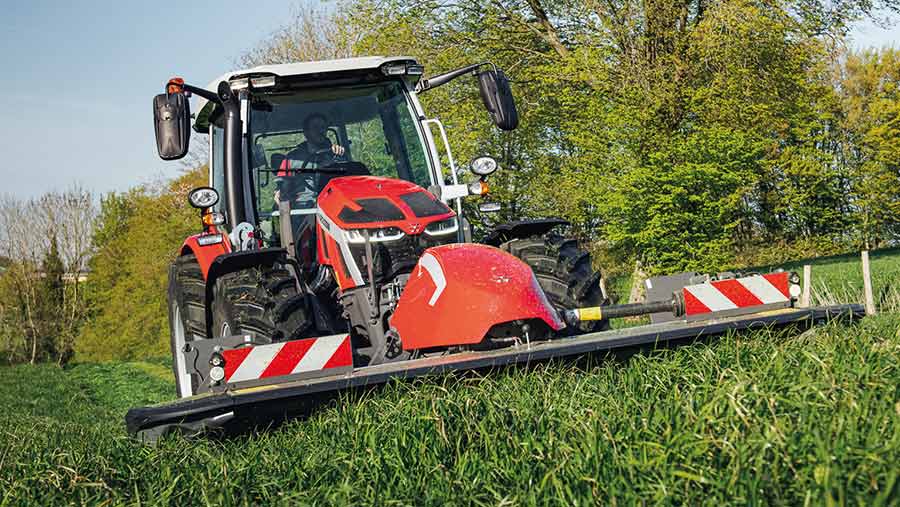
MF disc mower © Massey Ferguson
Massey’s DM range of mowers is built by fellow Agco brand Fella and comes in three working widths, from 2.6m to 3.6m.
Beds are centrally mounted off a curved arm and come with adjustable hydraulic suspension, as well as a compensating cylinder to prevent the bed flopping around when turning at the headland.
They also have an automatic breakaway system to protect them during collisions.
Mower beds are fitted with oval discs carrying two blades, which have a conical shape so that they lift forage off the ground for a cleaner cut.
Protection is also built in, with a so-called “Driveguard” plate that shears before any damage is done to the driveline.
Vertical over-centre folding makes the machine narrow on the road, and it can be stored in this position when suitable stands are fitted.
The DM316TL-V comes with six discs that give a 3.1m working width and it has a retail price of £17,992.
For those looking to add a front mower, the £15,196 DM316 FP is a suitable partner.
This has a 3.12m working width and comes with a push-type headstock featuring an oscillating linkage to help it follow contours.
